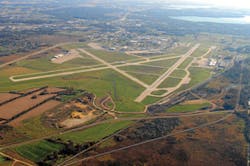A Lesson in Coordination
Dane County Regional Airport in Madison, WI and consulting firm Mead & Hunt, also based in Madison, recently received accolades for completion of a runway safety area project. Here, the consultant's lead project manager on the MSN project shares her insights on the scope of the project. A central component that led to the success of the project was the up-front coordination with the various agencies involved.
The majority of aviation accidents occur in close proximity to an airport. Runway safety is one of the Federal Aviation Administration's (FAA) top safety priorities.
In the late 1990's, the FAA initiated a national directive to address non-compliant safety areas. It subsequently identified the non-standard runway safety area (RSA) of runway 14/32 at Dane County Regional Airport as a high priority safety improvement project. Encroachments into Runway 14's safety area included a creek, a railroad, and the airport perimeter road. The solution required relocating a number of major structures outside the RSA.
Up-front Challenges
Bringing this runway safety area at MSN into compliance was a challenge from the start. Beyond Runway 14 lies Cherokee Marsh. Covering more than 2000 acres, the marsh is among the largest contiguous wetlands in Dane County. Approximately 340 acres of the marsh have been designated as a State Natural Area.
During the initial stages of the project, field surveys were conducted for populations of listed birds, plants, and butterflies within the Natural Area — home to a fen, a rare groundwater-dependent wetland and a number of rare plants and animals.
Agency and public involvement early in the process was key to its success. At the same time, explaining and getting buy-in of the need for the project from these parties was a major hurdle.
Once the need was established and demonstrated early in the project, there was a spirit of cooperation among all involved for the remainder of the project. In all, the airport and Mead & Hunt, Inc. coordinated with ten federal, state, and local agencies as well as local environmental groups and University of Wisconsin staff over a four-year period to develop a solution which minimized impacts and provided a comprehensive mitigation plan. The mitigation plan needed to be on-site because of the high value of the resource impacted.
As part of the mitigation planning, control of and potential hazards to wildlife were evaluated and minimized in any newly created or flooded wetland areas.
Project Breakdown
Components of the project included:
- Relocating over one mile of a creek;
- Relocating 2.4 miles of active rail line (which was designed to meet both current freight operation and the future needs of high-speed rail operations);
- Relocating 0.8 miles of two-lane county highway;
- Relocating the airport perimeter road and fence; and
- Clearing up an airfield intersection with conflicting markings.
Subsequently, the mitigation components included:
Restoring water levels: Filling in approximately 10,000 feet of drainage ditches within the marsh during the winter of 2004-2005 to enhance about 90 acres of fen. Filling while the ground was frozen using low-ground pressure bulldozers minimized disturbance in the marsh.
Early monitoring results show that the hydrology of the fen has been significantly enhanced, the goal being to restore pre-drainage groundwater levels.
Enhanced stormwater management and water quality: Relocating the creek out of the runway safety area and further from the aircraft operations area included construction of a 100-foot wide, 13-acre floodplain which will enhance stormwater management and water quality. Ten acres of wetland fill adjacent to the creek were removed to restore riparian hardwood swamps.
Buffers to the marsh were created by converting some 40 acres of leased crop land to deep-rooted native vegetation to reduce runoff and pollutants.
Encourage native plant growth, preserve genetic diversity: Native seeds were harvested to restore the filled drain ditches. This was a cost-effective alternative to commercial seed which will encourage native vegetation to grow, while helping to preserve the fen's genetic diversity.
Rail bridge: At MSN, over 3000 feet of the rail line is elevated onto a bridge trestle system. Required because of soil conditions, this raised rail allows water and wildlife to pass beneath. The bridge construction was performed from the bridge, keeping equipment out of the marsh. Working from each end of the bridge, the contractor was able to complete the 112 – span structure on schedule, while minimizing the work that had to be completed during the breeding bird season.
* * *
When finished, these mitigation measures are expected to produce positive impacts on the surrounding area. These efforts and successes were recognized by the FAA in the presentation of its first Outstanding Achievement Award for Environmental Stewardship to the airport this fall at the Great Lakes Region 22nd Annual Airport conference. The award cites the "extraordinary measures" the airport took to protect the environment while improving the RSA.
The runway safety area improvements were completed in late 2006. The project included moving a busy county highway with daily traffic counts nearing 10,000 vehicles and constructing a new at-grade railroad crossing without shutting down the road.
Airside improvements are expected to be completed in early 2007. When fully completed, it's not only the airport that will enjoy improved safety, but commuters as well, as the redesigned road removes a sharp curve.
Laura Morland, P.E. is a Senior Project Manager at Mead & Hunt, Inc. in Madison, WI. She has more than 25 years experience managing and being a team member of multi-disciplinary environmental projects. Aviation projects have ranged in size from general aviation to mid-size hubs. She can be reached at [email protected].
